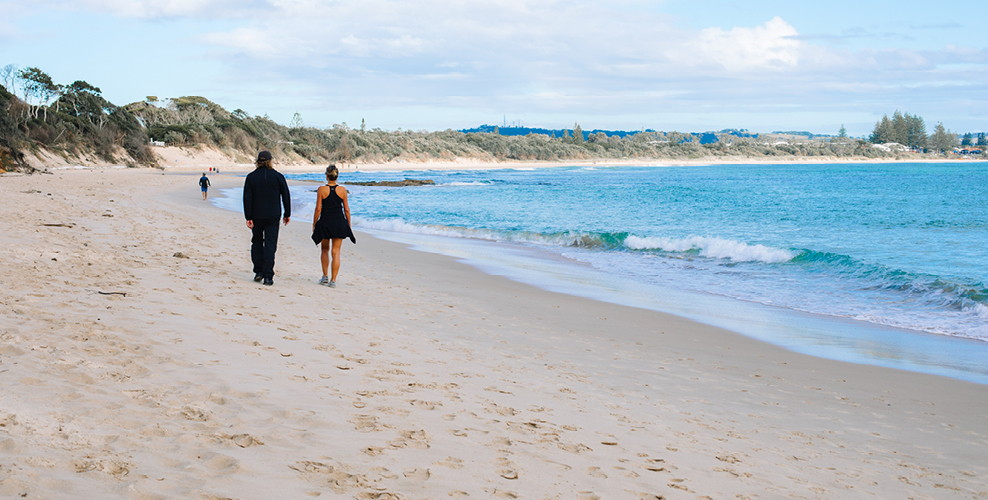10 reasons why walking is the perfect form of exercise

Most of us spend some portion of our day wandering around on our own two feet. But between our work lives and our leisure time, more than half of all adults in Australia aren't spending nearly enough time on the move - and our health is suffering as a result1.
If that's a familiar story, here are 10 reasons to add a brisk walk into your daily routine.
1. Walking suits almost everyone2
The reason walking is considered the perfect form of exercise is that it's easy for almost all able-bodied people to incorporate into their lives.
You don't need any training or special equipment, you can do it at any age, and you can adjust its intensity to your fitness levels and its duration to suit your schedule.
Furthermore, you're unlikely to injure yourself while walking, and you can do it anywhere you like.
Sounds pretty perfect to us!
2. Walking might help you live longer
Research3suggests that the more you walk now, the longer you're likely to live in the future.
One recent study3measured the daily steps of middle-aged and older people (40 to 85 years old) over seven days. The participants' health was then monitored at regular intervals over the following nine years.
At the end of that time, those who'd been doing the most walking at the start of the study were more likely to still be alive than those whose step counts had been low.
In fact, researchers estimate that for every extra 1000 steps you habitually take each day, your chances of still being alive 10 years later improve by 6%.3,4
How's that for motivation?
3. Walking reduces your risk of cardiovascular problems
Many of walking's benefits on overall health and wellbeing may be due to its positive impact on key risk factors for cardiovascular problems, specifically5:
- Body mass and body mass index (BMI)
- Body fat percentage
- Blood pressure
- Fasting glucose
- Aerobic fitness
4. Walking helps you keep weight off
If you've previously been sedentary, embarking on a walking program could help you reduce both your body weight and your fat stores - while also improving your aerobic fitness6.
And over the long term, being a regular walker may help you keep your youthful figure too!
It's considered normal to gain weight as you get older, and women are more susceptible to age-related weight gain than men7.
A long-term study8found that overweight women who walked more than 4 hours a week at the start of the study gained 8 kg less weight over the subsequent 15 years than those who didn't exercise, and those who walked for 2 hours per week put on 4 kg less.
Men also reduced weight gain with this amount of walking, but to a lesser degree.
In other words, this research indicates that every extra half hour of walking you do each week adds up to half a kilo of weight you won't put on.
And as this study shows, the long-term benefits could be significant!8

5. Walking for better blood sugar
Maintaining healthy blood sugar is an important part of maintaining overall health and wellbeing - and walking could have benefits here too. To significantly reduce your risk of developing certain blood sugar issues as you get older, aim for at least 2.5 hours of brisk walking every week9.
6. Craving chocolate or sugar? Take a walk!10,11
If you're prone to eating chocolate and other sugary snacks, research indicates that your desire for them is likely to be diminished by taking a brisk 15-minute walk.
At the same time, the walk could also help reduce physical and psychological responses to stress, which are common triggers for the urge to eat sugary snacks like chocolate in the first place.
It's a win-win!
7. Walking and bone health
Walking is a form of weight-bearing exercise, so it may help to maintain bone mineral density and inhibit bone loss in post-menopausal women12.
For optimal impact on your bone health, make sure to walk at a brisk pace, and to sustain your walking habit over the long-term12.
8. Relief for chronic low back pain
If you suffer from chronic lower back pain, getting into the habit of walking may help to relieve your symptoms and reduce their impact on your life - but check with your healthcare professional before you start to make sure that it's a suitable strategy for your personal circumstances13.
9. Walking maintains joint function in osteoarthritic knees
Osteoarthritis is a degenerative condition in which the function of affected joints typically declines over time.
But in a study involving people who either had osteoarthritis of the knee or were at risk of developing it, researchers found that compared to people who didn't walk much, those who walked 5000 - 7499 steps per day at the beginning of the study were about half as likely to experience joint function problems two years later.14
Researchers estimated that every additional 1000 steps per day a walker took at the start of the study led to 16-18% less joint function decline over the following two years.14
That's a big difference!
However, if you've got a touch of osteoarthritis in your knees, or if you're at risk of developing it in the future (for example due to being overweight or because of past injuries), talk to your healthcare professional about whether walking more might help.
Assuming they give you the go-ahead, start slowly; your goal is to start with 3000 steps each day and build up to at least 6000 steps over time.14
10. Walking gets you off your butt
Perhaps the most important reason to increase your daily step count is that every minute that you spend out and about is a minute you're NOT sitting still - and being sedentary is associated with a plethora of health issues, including weight, blood sugar and cardiovascular problems.15,16

How much should you walk? And how fast?
If you're not currently doing any exercise, any walking at all is better than none.
Adults are recommended to be active almost every day, and to exercise for either 150-300 minutes per week at a moderate intensity, or 75-150 minutes per week at vigorous intensity1.
In most cases, brisk walking is considered a moderate intensity activity, so to meet those targets you'll need at least 30 minutes of brisk walking, five days a week - but more is even better!
What's a 'brisk' walk?
For your walk to be considered 'brisk' or 'moderate intensity' you need to be taking at least 100 steps a minute. (Older people may be able to reach moderate intensity at a slightly slower pace, however).17
If you're not yet fit enough to maintain that pace for long, keep walking anyway, because some of the benefits of walking have been documented to occur at 70-80 steps a minute too.17And in any case, the more you walk the fitter you'll get!
Ready to dial up to 'vigorous' intensity? You'll need to walk even faster, at 130 steps per minute (by which point you may actually find yourself on the verge of running).18
Other ways to increase your walking intensity are to walk on a steep incline, to include lots of stair climbing in your route, or to carry weights while you walk.6
How do you know how fast you're walking?
To work out whether you're achieving that magic speed of 100 steps per minute, grab your smartphone or wearable device and make a note of both the time and the number of steps you've already taken that day.
Then set an alarm to go off in 15 minutes and start walking at your usual pace. When the alarm goes off, subtract the step count you started at from the final step count. Then divide by 15 to work out your average number of steps per minute.
References:
- Australian Government, The Department of Health. Australia's Physical Activity and Sedentary Behaviour Guidelines and the Australian 24-Hour Movement Guidelines. Published 2019 and accessed Oct 2020:https://www1.health.gov.au/internet/main/publishing.nsf/Content/health-pubhlth-strateg-phys-act-guidelines#npa1864
- C3 Collaborating forHealth. Review: The benefits of regular walking for health, well‚Äêbeing and the environment. Published 2012 and accessed Oct 2020:https://www.c3health.org/wp-content/uploads/2017/07/C3-report-on-walking-v-1-20120911.pdf
- Hansen, B.H. et al. Scand J Med Sci Sports, 2020;30(9):1705-11.
- Hall, K.S. et al. Int J Behav Nutr Phys Act, 2020;17(1):78.
- Oja, P. et al. Br J Sports Med, 2018;52(12):769-75.
- Franklin, B.A. Prev Cardiol, 2006;9(1):56-9.
- Mekary, R.A. et al. Int J Obes (Lond), 2009;33(9):1039-47.
- Gordon-Larsen, P. et al. Am J Clin Nutr, 2009;89(1):19-26.
- Jeon, C.Y. et al. Diabetes Care, 2007;30(3):744-52.
- Ledochowski, L. et al.PLoS One, 2015;10(3):e0119278.
- Taylor, A.H. & Oliver, A.J. Appetite, 2009;52(1):155-60.
- Benedetti, M.G. et al. Biomed Res Int, 2018;20184840531.
- Sitthipornvorakul, E. et al. Musculoskelet Sci Pract, 2018;3438-46.
- White, D.K. et al. Arthritis Care Res (Hoboken), 2014;66(9):1328-36.
- Johansson, M.S. et al. Int J Behav Nutr Phys Act, 2020;17(1):84.
- Panahi, S. & Tremblay, A. Front Public Health, 2018;6258.
- Tudor-Locke, C. et al. Br J Sports Med, 2018;52(12):776-88.
- Tudor-Locke, C. et al. Int J Behav Nutr Phys Act, 2019;16(1):8.
















